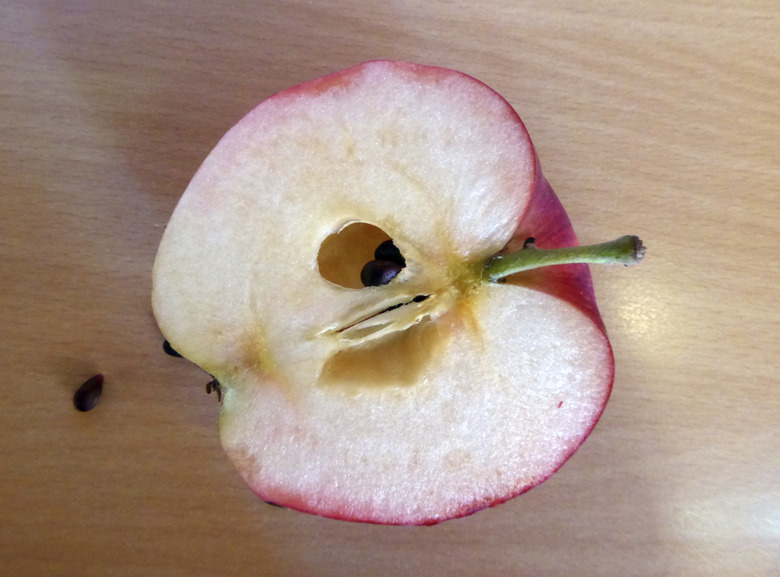What Is An Apple Pip?
"Pip" means the seed of an apple (Malus domestica). A simple way to view the pips is to cut an apple in half, revealing the tough core that houses varying numbers of seeds based on the type and the health of the parent plant. A single apple seed, however, rarely produces the same type of tree from which it was grown. Most apple trees today are hybrids, or crosses, of at least two other types, with the focus placed on developing more disease-resistant or more productive varieties. Pips must undergo a cooling period in order to germinate properly.
Cool Your Pips
Hardy in U.S. Department of Agriculture plant hardiness zones 3 to 8, apples are grown from pips that have been chilled at a steady temperature of 40 degrees Fahrenheit during a period of dormancy that is also called after-ripening. This subjects the pips to the same conditions they would experience if left outside during the winter. In fact, planting the seeds outside in the fall is one way to accomplish the after-ripening, during which the seed's embryo develops fully and becomes capable of producing new growth. The other method involves refrigerating the seeds for a specific time before planting them.
- "Pip" means the seed of an apple (Malus domestica).
- A simple way to view the pips is to cut an apple in half, revealing the tough core that houses varying numbers of seeds based on the type and the health of the parent plant.
Germination Rate
According to the University of Minnesota Extension's website, fruit trees sold commercially are grown using root stock and scion, plus a secondary variety stock that is grafted onto the root stock. If you plant apple pips — after the chilling process — it takes another six to eight weeks before they germinate.
Connell Apple Trees
Connell Red apple trees are a mutation from the Fireside McIntosh apple, which is a red apple with yellow markings. The new variety of apple was named after him in 1957. Grow Connell apple trees for edible landscapes, shade trees, accent plants and orchard trees. Connell apple trees bloom late in the spring with clusters of white flowers tinted with pink. The dark green leaves change to yellow when the color fall weather occurs. This means that an apple tree, of a different variety, that blooms at the same time must be planted nearby. Connell apple trees are prone to diseases like mildew, scab, fire blight, apple rust disease, black rot and bitter rot. Connell apple trees must be grown in full sunlight. Because of its height limit, it can be planted under overhead wires. This variety of apple tree will lives over 50 years in good growing conditions.
- According to the University of Minnesota Extension's website, fruit trees sold commercially are grown using root stock and scion, plus a secondary variety stock that is grafted onto the root stock.
- Because of its height limit, it can be planted under overhead wires.
References
- University of Minnesota Extension: Growing New Fruit Tree Plants from Seed
- The Old Farmer's Almanac: Apples
- University of Illinois Extension: Apples and More: Apple Facts
- Terry Ettinger Horticultural Consulting Services: Growing Apple Trees From Seed
- University of California Cooperative Extension: Low-Chill Apples
- Sunset: Apple
- Journal of the American Pomological Society: Connell Red Apple
- Alger County Courthouse: Fruit Trees
- Sun Valley Garden Center: Connell Red Apple
